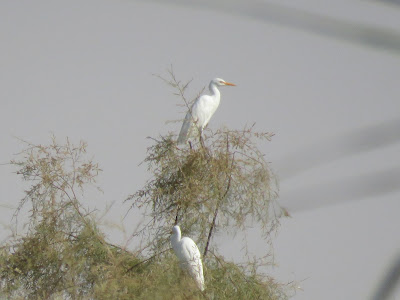Last weekend I returned to Al Hayer after a break away due to work and illness. I was still not feeling tip top so only had a short walk among my familiar friends. However, you can never tell what you are about to come across when birding in Saudi Arabia. In this instance I had the pleasure of spotting the following amazing creature;
 |
| black-winged kite (Elanus caeruleus) |
Perched in a tree about 20 meters away was a Black Winged Kite, a very rare visitor to the area. I know they are seen occasionally in the Eastern Region but not around Riyadh. He did not seem overly bothered by my presence so I got to watch for a while, eventually remembering to take some photos. Eventually he flew off to the north, however to my amazement about 5 minutes later I spotted another coming in from the west over the reeds and flying low across the reeds. I'm still trying to make something of a poor in flight shot and will put it up here when I can but, what can I say, like a London bus, wait and wait then 2 show up !!
 |
| desert finch (Rhodospiza obsoleta) |
In the bushes was a small flock of Desert Finch. I have seen these in the area a few times before but generally limited to one or two birds, in this instance there were 8 to 10. A pretty little bird.
 |
| purple heron (Ardea purpurea) |
The Heron family was well represented today with the Purple Heron making an early pass over where I stood.
 |
| squacco heron (Ardeola ralloides) |
And I guess around 25 Squacco Heron feeding away in the long crops. They show up en-mass at this time of the year and spend most of the winter around the area.
 |
| cattle egret (Bubulcus ibis) |
However the real flock winner for this week was the Cattle Egret which were really here in large numbers. The photo below was not able to capture the full flock but got most of it, over 100 birds I guess.
 |
| cattle egret (Bubulcus ibis) 75+ |
In addition to these guys there were a small number of Grey heron about but I did not manage to photograph them on this occasion.
 |
| Indian silverbill or white-throated munia (Lonchura malabarica) |
Another bird that often appear is flocks is the Indian Silverbill but on this occasion there were only a small number to be seen.
 |
| common myna (Acridotheres tristis), |
The Common Myna are regular visitors to the area and usually in small flocks. On this occasion there were only 2 that I saw but it may be there were more in among the crops.
 |
| crested lark (Galerida cristata) |
As always there were a good number of Crested Lark about the place. This one is well hidden in plain sight, most are heard well before they are seen as they have a distinctive chirp.
 |
| white-throated kingfisher (Halcyon smyrnensis) |
Another familiar sight around the area is the White Throated Kingfisher, today they were hanging around their favourite perch on the sprinklers. There were 3 about today, two appeared to be together while the third was a short distance away.
 |
| Namaqua dove (Oena capensis) |
There were a good number of Namaqua Dove around today and, as always, a large number of Laughing Dove.
 |
| barn swallow (Hirundo rustica) |
This is a longish range shot showing the Barn Swallows lined up on the wires preparing to head south for the winter. There were in excess of 50 on the wires around the fields and about the same number feeding all around the area. I expect they will be moving off in the next week or so.
 |
| green bee-eater (Merops orientalis) |
A favourite resident is our little friend the Little Green Bee Eater. My day is never complete until I have seen at least one of these. As it happens I only did see the one on my walk but there were 5 or 6 on a wire as we drove back so there were more about.
 |
| white-eared bulbul (Pycnonotus leucotis) |
The White Eared Bulbul were also about in good numbers though not as vocal as they normally are, might not have been a good day for them. There were also a good number of Graceful Prinia about the place but I did not manage to get any photos of them this time.
 |
| red avadavat, red munia or strawberry finch (Amandava amandava) |
A common enough visitor is the Red Avadavat, there were 7 or 8 of these about today and I heard a few others singing in the reeds. This one looks like he is carrying nesting material
 |
| common moorhen (Gallinula chloropus) |
All over the wetland areas were the Common Moorhen. They are all very skittish as there are one or two hunters about but managed to get this shot.
As I said this was a short walk today lasting about 2 hours but nonetheless exciting. All goes to prove you never know what you will come across while birding.
No comments:
Post a Comment